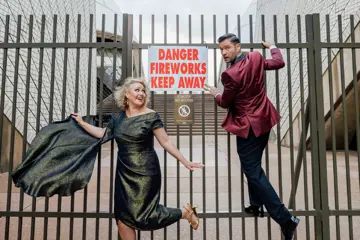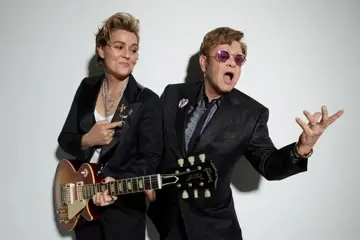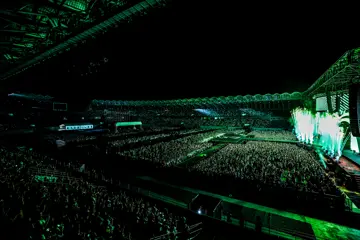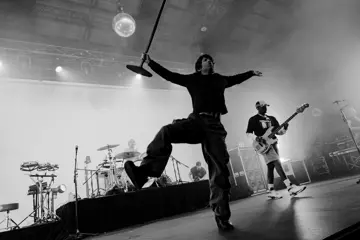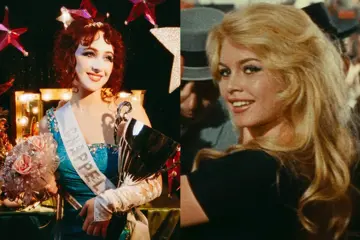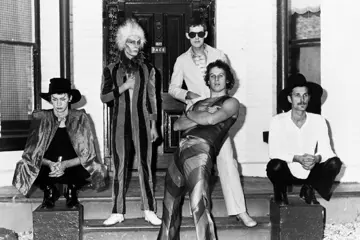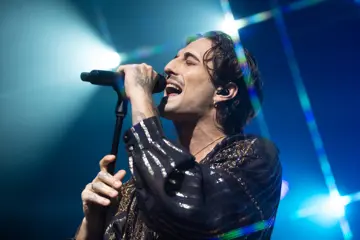For revolutionary designers Viktor Horsting and Rolf Snoeren, collectively known as Viktor&Rolf, fashion is the language of fantasy.
Few people could imagine themselves wearing one of the Dutch duo's bizarre haute couture masterpieces, but these clothes aren't meant of our humdrum, everyday reality. Viktor&Rolf are storytellers who use seams and stitches to conjure extraordinarily virtuosic worlds. During their 23-year partnership, these two visionary designers have pushed their collections to avant-garde extremes, playfully defying expectations of fashion and beauty.
Cubist-inspired sculpture suits; vast wheat sheaf headdresses; Swiss cheese-esque holed chiffon ball gowns; duvet dresses with built in pillows. Each of their concepts has elevated the vernacular of clothing design, both creatively and technically, to a surreal stratosphere where the constraints of rusted-on "ready to wear" consumerism no longer hold any sway. In fact, if one were to argue semantics, Viktor&Rolf are closer in their thinking and methodology to theatre-makers and visual artists than to traditional, mainstream fashion designers.
 Viktor&Rolf Spring/Summer Collection 2015
Viktor&Rolf Spring/Summer Collection 2015
Acknowledging fashion as a legitimate art form is a fervent belief of curator Thierry-Maxime Loriot; for him, the clothes of designers like Viktor&Rolf have as much right to be in a gallery as they do on a catwalk. "The average haute couture show lasts for roughly 17 to 22 minutes. If you're lucky enough to be one of the spoilt few who are invited to see designs on the catwalk then you'll see each ensemble for just a few moments, but the level of craftsmanship required to create these clothes involves hundreds of hours of work," Loriot explains. "It's more difficult, I think, to see a haute couture garment than it is to see a Picasso painting, let alone have the time to really experience the detail and skill involved in its construction."
Loriot is a pioneer in placing contemporary fashion in a gallery context. In 2011, he curated the first museum retrospective of French fashion icon Jean Paul Gaultier, but at the time, the idea of transplanting such radical designs into the relatively sterile environment of an exhibition hall left some naysayers unconvinced. To say Loriot proved them wrong would be quite an understatement. Infusing the displays with the same mischievous theatricality as Gaultier's designs, including mannequins with projection mapped faces who burst into song as attendees passed, the gallery treatment not only did the clothes justice, it amplified their tongue-in-cheek drama. The show was a smash-hit success, touring all over the world including Melbourne in 2014, so it's little wonder, given this gold plated case study, that Viktor&Rolf have entrusted Loriot to deliver their first museum show, opening this week at the National Gallery of Victoria.
"They are driven by creativity and originality and the desire to show something that nobody's seen before. Personally, I think that's what fashion should be about."
Don't miss a beat with our FREE daily newsletter
As with his acclaimed Gaultier show, Loriot's approach has drawn on the narrative subtexts that have consistently underpinned Viktor&Rolf's catwalk presentations. "They work exactly the opposite of other designers. When they create they always start with a concept and then make the collection according to that idea. It's not about following trends like, 'Pink is in this season'. They don't work that way," Loriot observes. "They are driven by creativity and originality and the desire to show something that nobody's seen before. Personally, I think that's what fashion should be about."
Viktor&Rolf: Fashion Artists is "more of a contemporary installation than a retrospective," Loriot says and it's clear that his curatorial ideas have been guided by an absolute respect for the two fashion iconoclasts."When you work with living artists, it’s important to make something that pays homage to their vision," Loriot notes. "I don't want them to think, 'Oh my god, what is this? I don’t recognise my work!'"
More than 40 works will be on display, including a nine-layered "Russian Doll" inspired collection and the 2004 wedding dress created for Holland's Princess Mabel. Visitors will also travel through a Japanese Zen garden and meet a collection of porcelain fashion dolls, referencing aspects of Viktor&Rolf catwalk shows. Rather than being organised chronologically, the exhibition has found its flow via the character and emotion of the designs in a way that celebrates the whimsical, nonconformist thinking behind these clothes.
 Viktor&Rolf Couture Collection 2013
Viktor&Rolf Couture Collection 2013
Art galleries have become increasingly in vogue in recent years as venues for designers to present their latest work, but the highbrow credibility this setting implies isn't always impartial. By contrast, Loriot's curatorial approach is fiercely independent of the commercial factors of the fashion industry; protecting the authenticity of the exhibition is a primary concern. "There's a very noticeable difference between exhibitions that are initiated by a museum and those that are sponsored by a brand in order to sell something. It's very important that people understand this exhibition is a celebration of the work of artists, rather than a platform to cross promote something," Loriot insists. "In the fashion industry, I think creativity and individuality are becoming more and more scarce because consumerism is such a powerful force. It's really difficult now for fashion designers to survive in this type of environment and that's why exhibitions like this are vital to showcasing the emotional and dramatic potential that can be captured through clothing."
The National Gallery of Victoria presents Viktor&Rolf: Fashion Artists, 21 Oct 2016 — 26 Feb 2017.


